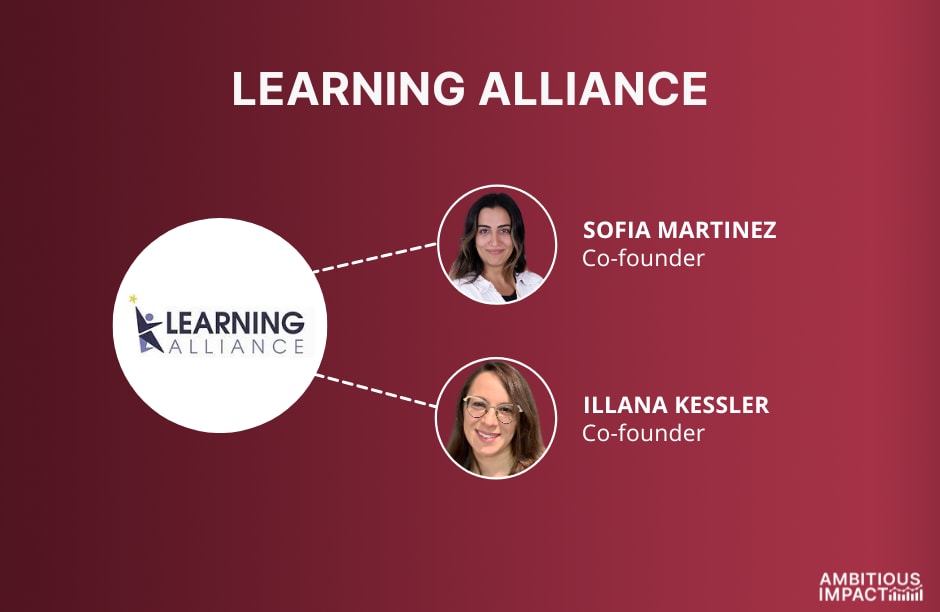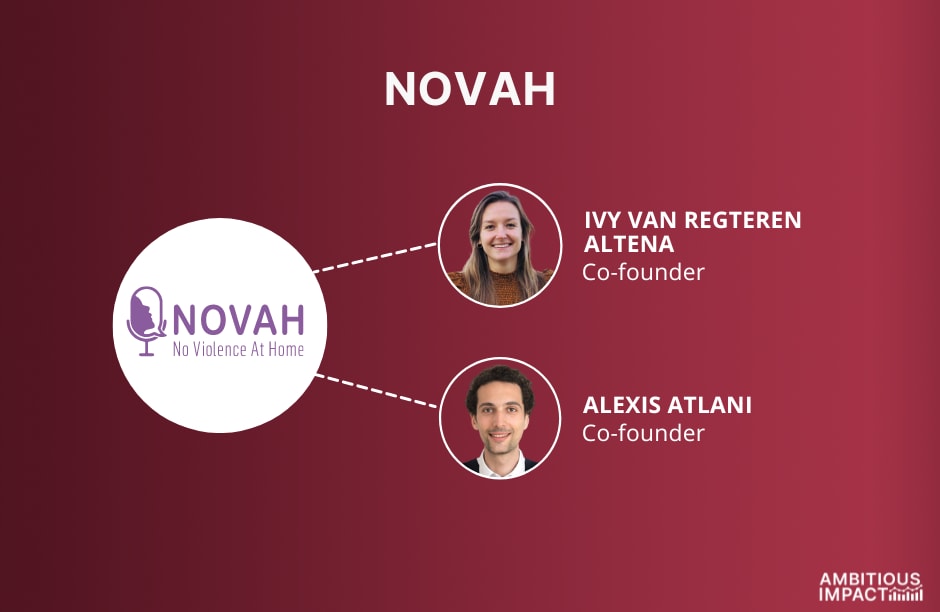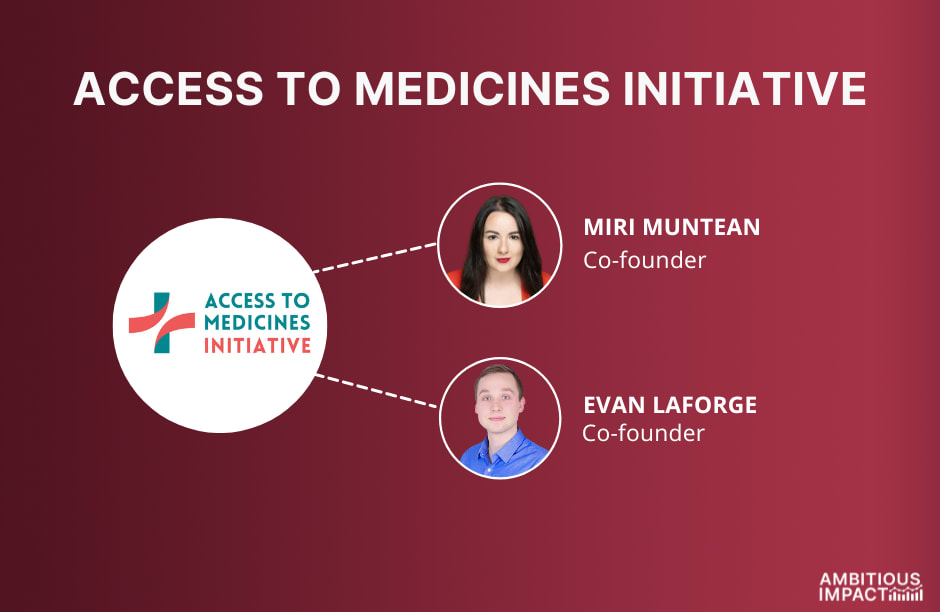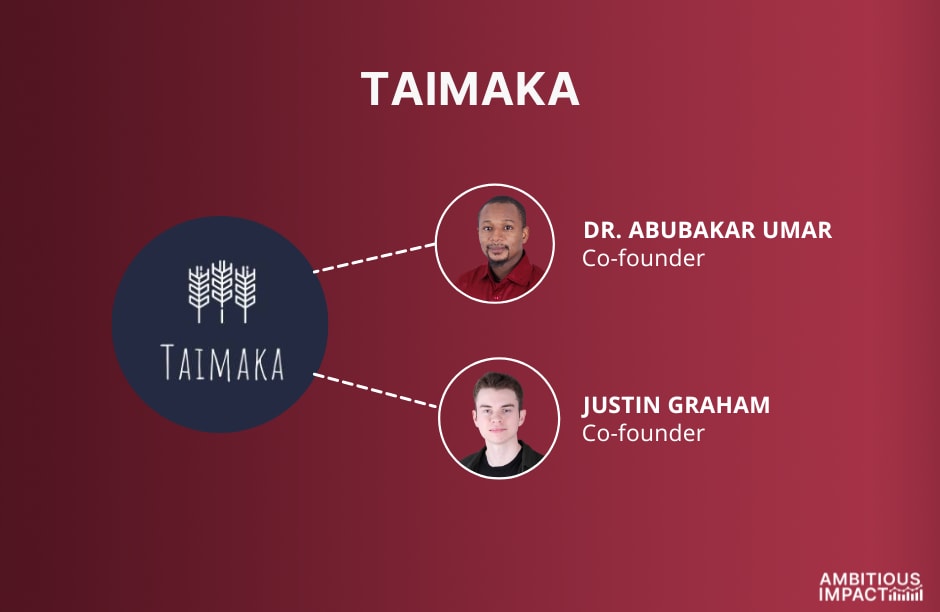Presenting nine new charities - a record for the AIM (CE) Incubation Program
By Ambitious Impact, anusha @ 2024-05-14T10:12 (+208)

We are thrilled to introduce nine new charities launched through our February-March 2024 Incubation Program. This is an AIM record with an average of five charities launched per round in the previous years. We are also proud to announce that thanks to very generous donors from the Seed Network Funding Circle, these new organizations have secured over $1 million in funding! This is a significant milestone for AIM as an organization. We are very grateful for the support of our funders, mentors, and, most of all, the talented applicants who decided to pursue entrepreneurial careers in the nonprofit sector.
We are committed to ongoing support for these new initiatives through mentorship, operational assistance, free co-working space in London, and access to an ever-expanding entrepreneurial network of funders, advisors, interns, and fellow charity founders.
This article provides a brief introduction to our new organizations. You will find more information in the sections below if you want to support some charities with further funding or are interested in volunteer opportunities. If you want to launch a high-impact charity, please visit our website and subscribe to our newsletter.
We are excited to unveil the February-March 2024 Incubation Program cohort:
- Notify Health improves life-saving vaccine coverage for children through effective and scalable vaccination reminders.
- Learning Alliance tackles the foundational learning crisis by bringing evidence-based teaching practices into classrooms
- Novah works towards the reduction of intimate partner violence.
- Access to Medicines Initiative addresses contraception stock-outs.
- FarmKind aims to close the funding gap for some of the most impactful animal welfare charities.
- Ark Philanthropy helps high-net-worth individuals create philanthropic strategies to address global challenges.
- Taimaka specializes in acute malnutrition treatment.
An introduction to each charity:
Notify Health
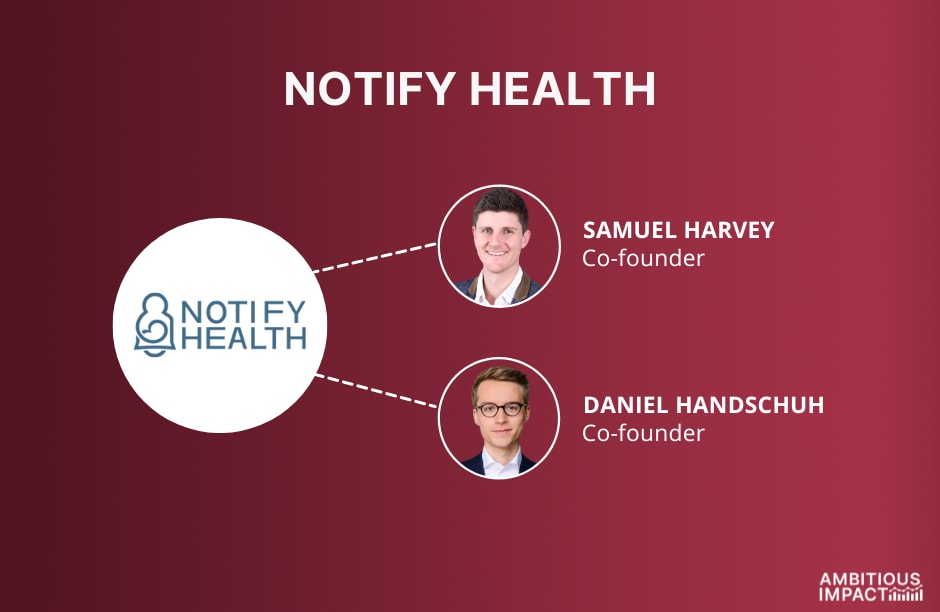
Co-founders: Samuel Harvey | Daniel Handschuh
Website: https://www.notifyhealth.org/
Email address: info@notifyhealth.org
CE incubation grant: $179,000
Description of the intervention:
Notify Health aims to increase life-saving vaccination coverage rates in sub-Saharan African countries by implementing a well-evidenced, cost-effective, and scalable intervention: Reminder messages for childhood vaccinations.
We achieve this by:
- Creating or identifying databases of children’s birth dates and caregivers’ phone numbers.
- Designing informative and persuasive reminders tailored to the local context and selecting the most impactful and cost-effective communication channels and mediums (e.g., SMS, voice, app-based).
- Sending messages aligned with the local vaccination schedule at scale and automated through mass-messaging systems.
Background of the intervention:
Twenty million children still miss out on life-saving vaccines annually, and unfortunately, progress on coverage is stagnating or reversing. As a result, more than 700,000 children die every year, with >50% of them in sub-Saharan Africa.
Vaccination reminders have strong evidence, including multiple RCTs and three Cochrane reviews, indicating that they can increase vaccination rates by several percentage points, including in the contexts in which we plan to operate. The success of GiveWell-funded Suvita provides practical evidence from India that reminders work cost-effectively at scale, reaching down to $4,356 per child death averted.
Near-term plans:
Starting in June 2024, we plan to conduct 3-week scoping visits (each) in two of our top countries (Nigeria, Ethiopia, Angola) to select our pilot location. During these visits, we aim to deepen our understanding of contextual factors (e.g., phone usage, language/culture, vaccination attitudes), the local healthcare system, and the vaccination landscape. We will meet with potential partners in the government and NGO/implementation sector to obtain approval and execution support for our planned pilot. Before launching our pilot, we will conduct a needs assessment, set up our mass messaging system, and design reminder messages. Later in the year, we aim to test our program with a three-month pilot to create a locally adapted intervention that we can expand on a regional and national scale.
Predicted Impact:
Our preliminary model indicates that for one of our priority countries, Angola, we might avert 80,000 - 130,000 DALYs or 3,000 - 3,500 child deaths at scale.
Cost-effectiveness:
GiveWell’s modeled cost-effectiveness of $4,365 per child death averted for this intervention in India gives a good first indication of what is possible. Coverage gaps to close for essential vaccines like DTP-3 in many African countries where we plan to work are 4-6 times larger than in India. Our initial modeling indicates that achieving cost-effectiveness below $4,000 per child death averted is possible in this context, and this is our aim.
Room for More Funding:
We are not currently fundraising but are always looking for volunteers interested in researching vaccinations and behavior change, implementing technology for mass-messaging systems, and supporting charity operations and strategy. You can subscribe to updates and learn about future funding and support opportunities in our newsletter.
Learning Alliance
Co-founders: Ilana Kessler | Sofia Martinez
Website: www.learningalliance.net
Email address: ilana.kessler@learningalliance.net | sofia.martinez@learningalliance.net
CE incubation grant: $173,000
Description of the intervention:
Learning Alliance is a non-profit that tackles the foundational learning crisis in Sub-Saharan Africa by bringing evidence-based teaching practices into classrooms and supporting teachers in delivering an excellent education to every child. We aim to scale our impact by partnering with schools and Ministries of Education, focusing on operational excellence, scalability, and cost-effectiveness to achieve the ultimate goal: more learning.
Structured Pedagogy is an evidence-based approach to improve learning outcomes by helping teachers be more effective. It involves providing simple, daily lesson plans for teachers to follow, training, and ongoing coaching to use the new techniques. Learning Alliance has identified excellent open-source structured pedagogy material. We plan to adapt these for schools in neglected geographies by developing highly cost-effective scaling models to scale these tools and practices nationally.
Background of the intervention:
Most students in Sub-Saharan Africa attend school but learn very little. For instance, 86% are unable to read with comprehension by the end of primary school. Math skills are similarly far behind (The State of Global Learning Poverty: 2022 Update). This limits their life prospects: a meta-analysis studying the effect of skills on income suggests that a one standard deviation increase in test scores leads to a 10-45% increase in individual income (Hanushek et al., 2016). In other words, the path out of poverty - for individual children and their countries - likely runs through an effective classroom.
The scale of this challenge is vast, and so is the opportunity: There are roughly 500 million children under the age of 15 in Sub-Saharan Africa. Researchers have identified evidence-based solutions like structured pedagogy and teaching at the right level, which can significantly impact at a relatively low cost. These solutions still need to reach most children and schools.
Near-term plans:
We are currently doing desk research, making calls with experts, and conducting country visits to identify the geographic areas where Learning Alliance can best contribute and learn from existing organizations. We will begin in-country work with 2-3 schools in September 2024, aiming to partner with schools throughout the fall semester to test and iterate our program model. In the spring semester, we will pilot a small-scale program in 5-10 public schools to measure learning outcomes while refining our program’s approach.
By the end of the spring semester in 2025, we hope to have shown promising indications of a substantial impact on learning outcomes, which we will use to scale to 50-100 schools in year 2, focusing on refining program design for impact, cost-effectiveness, and scalability. We hope to conduct an RCT in year 2 or 3.
Predicted Impact:
A strong body of evidence (Snilstveit et al., 2015) shows a large and consistent impact of Structured Pedagogy on learning outcomes. A multi-year, nationwide study in Kenya found that Structured Pedagogy increased learning by 0.83 standard deviations, significantly affecting education. Beyond learning outcomes, there is high-quality evidence that improved educational outcomes lead to substantial income improvements for participants; a one standard deviation increase in test scores leads to a 10-45% increase in individual income (Hanushek et al., 2016).
Cost-effectiveness:
Our cost-effectiveness analysis projects an increase of $189 in students’ lifetime income for every $1 spent. This is equivalent to the benefit of 35x cash transfers per GiveWell donation. This intervention has the potential to be extremely cost-effective because it is highly leveraged: African governments have spent considerable sums to build schools and employ teachers, with relatively little investment in quality. Thus, small investments in teacher effectiveness and leveraging existing school spending can deliver large learning gains.
Room for More Funding:
Learning Alliance currently has a runway of 14 months. This will allow us to develop a Minimum Viable Product (MVP) for the program in partnership with 2-3 schools and set up a small-scale pilot program in the 2025 spring semester. We will use additional funding to increase the scale of the pilot and control group in the spring semester to measure outcomes robustly and hire extra staff to allow us to move faster towards a scalable model of our program in years 2 and 3.
Novah
Co-founders: Alexis Atlani | Ivy van Regteren Altena
Website: www.novah.ngo
Email address: alexis@novah.ngo, ivy@novah.ngo
CE incubation grant: $165,000
Description of the intervention:
Novah, short for No Violence at Home, is committed to preventing intimate partner violence (IPV), or domestic abuse, against women through mass media. We design, produce, broadcast, and evaluate edutainment radio shows that merge engaging stories with educational content based on the entertainment-education approach. These programs are designed to shift societal norms and behaviors towards women, aiming for a substantial reduction in IPV and, thus, a significant increase in health and well-being.
Background of the intervention:
Intimate Partner Violence (IPV) refers to harmful behaviors in a relationship, such as physical attacks, sexual coercion, emotional abuse, and controlling actions. Globally, one in four women has experienced IPV, with even higher rates in Africa. Recent academic studies have deemed mass-media interventions to prevent IPV very promising, and we want to be one of the first interventions to evaluate using radio rigorously.
IPV is the most common form of violence worldwide and leads to severe health issues, causing the death of 70,000 women each year. The impact of IPV is vast, with a global health burden of 8.5 million Disability Adjusted Life Years (DALYs), which is more than the combined health impacts of war and natural disasters. Children growing up in homes with domestic violence also suffer worse physical and mental health and are more likely to be involved in violence as adults, either as victims or perpetrators. Economically, IPV can cost countries up to 2% of their GDP. Despite the significant harm caused by IPV, the area is significantly underfunded.
Near-term plans:
Over the first two years, our plan will transition from a proof of concept to a comprehensive pilot program:
We are currently traveling in Kenya and Rwanda to choose the initial country of operations. We will start by carrying out a Proof of Concept from July to December 2024. This will consist of forming partnerships, researching the local context for IPV and the media landscape, and collaborating with local and international experts to write and produce content. We will then air a short regional radio campaign targeting 100,000 listeners and evaluate the impact through mixed research methods. If readers are well-versed on the topic or know experts we should talk to, please write to us.
In 2025, we will implement a comprehensive pilot with a rigorous quantitative evaluation. We will scale our content production to affect 1 million listeners, rigorously measure our impact (the change in IPV prevalence) through a regression discontinuity design, and assess our intervention cost-effectiveness.
We aim to build a scalable, impactful model for potential replication and future expansion in subsequent years.
Predicted Impact:
With our pilot study we want to reach 1 million listeners and estimate that it will free 15,000 women from violence for one year. We will then work nationally and more globally in Sub-Saharan Africa, where the burden represents millions of DALYs. On top of this impact, we aim to generate critical evidence for others to replicate this intervention as broadly as possible.
Cost-effectiveness:
We conservatively estimate we can reach a couple experiencing IPV for less than $2, and for every $23 spent, a woman will stop experiencing violence for a year. This mass-media approach is 6.5 times more effective than community-led IPV prevention programs currently endorsed by TheLifeYouCanSave. It leads to high cost-effectiveness, costing $70-100 to prevent the loss of a year of life, making it eight times more effective than cash transfers and comparable to GiveWell's top recommendations.
Room for More Funding:
We have secured funding for our first year, setting the stage for initial results during our proof of concept phase. During this phase, we aim to reach 100,000 listeners and will evaluate the impact using initial qualitative and quantitative research methods. The next stage, our complete pilot, is scheduled to begin in early 2025. We require an additional $191,000 for this phase to expand our reach to 1 million listeners. We conduct a rigorous quantitative evaluation with a regression discontinuity design, incorporating pre-post data and a control group.
Access to Medicines Initiative (AMI)
Description of the intervention:
The Access to Medicines Initiative is committed to reducing maternal mortality and supporting women's autonomy by ensuring the availability of contraceptives in public health facilities.
We plan to reduce stockouts of commodities by implementing a system capturing up-to-date information on stock and demand in health facilities and by working with local health authorities to improve the procurement and delivery of commodities.
Background of the intervention:
Every year, 218 million women wanting to avoid pregnancy do not use any modern method of contraception. Meeting all needs for contraception would avert 76 million unwanted pregnancies in low and middle-income countries. Multiple case studies show that addressing stockouts of contraceptives and other essential medicines can increase uptake by up to 48% in low-income countries.
In Nigeria, 6 out of 10 women of reproductive age wanting to avoid a pregnancy have an unmet need for contraception, leading to 3 million unwanted pregnancies every year. Fulfilling currently unmet needs for contraception in Nigeria would prevent 10,800 maternal deaths every single year. Currently, contraceptive distribution systems in Nigeria are based on distorted data, resulting in poor allocation and insufficient procurement. On average, Nigerian facilities are stocked out of at least one form of contraceptive 78% of the time.
Near-term plans:
Building on Miri´s previous work, we will visit Nigeria in May 2024 to scope out potential implementation states and select up to two locations for our pilot. Over the rest of 2024, we plan to run a pilot in up to 200 health facilities to test whether
- improved data visibility into demand and stock improves allocation
- improving allocation decreases stockouts (and to what extent)
- decreasing stockouts increases consumption (and to what extent)
- increasing the supply of contraceptives further increases consumption (to better estimate the necessity and impact of additional procurement work)
Predicted Impact:
Within five years, we hope to reduce the stockouts of contraceptives in public health facilities to below 5% in 18 Nigerian states before expanding to other countries. This would generate 200,000 additional contraceptive users, averting over 25,000 unwanted pregnancies and almost 250 maternal deaths every year.
A successful and cost-effective supply chain intervention could be expanded to numerous life-saving and life-enhancing medications, vaccinations, and other health advancements, playing a role in fostering global health equity.
Cost-effectiveness:
This intervention could cost $18 per DALY averted and $850 per maternal death averted if procurement advocacy is successful, and $34 per DALY and $1550 per maternal death averted if we directly cover all costs for additional procurement. Besides direct health benefits, this intervention would greatly improve the autonomy and subjective well-being of additional users of contraceptives. Access to contraceptives also increases women’s workforce participation while lowering health expenses, which results in significant economic benefits for their entire family.
Room for More Funding:
Thanks to the generous CE seed grant, we are fully funded for the following year. Additional funding would be used for a smooth scale-up in 2025, depending on the outcomes of our pilot. You can subscribe to updates and learn about future fundraising needs in our newsletter.
FarmKind

Co-founders: Aidan Alexander | Thom Norman
Website: Under construction
Email address: Aidan@FarmKind.giving | Thom@FarmKind.giving
CE incubation grant: $133,000
Description of the intervention:
FarmKind’s mission is to help close the funding gap for some of the most impactful animal welfare charities. We’re launching an online donation platform to reach a wide audience of potential new donors to effective animal charities.
Background of the intervention:
The best-evidenced animal welfare interventions are amongst the most cost-effective ways we have found to prevent near-term suffering.
Yet, these organizations remain critically underfunded. Faunalytics estimates that, globally, the total budget of all organizations working exclusively to relieve the terrible suffering of factory-farmed animals is just $120 million/yr. Less than the budget of ASPCA. Even in other effective giving organizations, of the donations we’ve analyzed, less than 1 in 10 dollars goes towards farmed animal welfare charities.
The result is that strategies that have been shown to be effective in relieving animal suffering can’t scale quickly, and it is much harder for new organizations to experiment with promising new interventions.
Through FarmKind, we aim to find new donors for the animal movement, grow the available funding, and share our insights on effective fundraising techniques with other high-impact organizations.
Near-term plans:
We are set to launch our donation platform in Q3 and our focus will then shift to donor outreach.
Our platform and messaging aim to engage individuals who are new to effective giving. We recognize that for most people, donating is primarily an emotional decision. Our strategy is designed to embrace this fact.
For example, our platform, inspired by the innovative Giving Multiplier model, allows donors to split their donation between a favorite charity, affirming their emotional giving motivations, and one that is highly effective, so they can also have a more significant impact, with a portion of the donation being matched. Caviola & Green (2023) show this approach can increase donations to effective charities by 173%.
Similarly, our messaging will diverge from the conventional communication styles of the EA community by emphasizing the emotional aspects of donation. We hope this will allow us to reach new audiences to effective giving.
If you are interested in supporting our efforts, here are two immediate opportunities:
- Research Participation: We are researching to understand public perceptions of farmed animals and charities. We are particularly interested in speaking with non-EA individuals concerned about climate issues, identifying as 'reducetarians', or donating to mainstream animal charities (e.g. ASPCA, WWF). If you know someone who fits this description and is willing to participate in an interview via Google Meets, please contact Thom at Thom@Farmkind.giving.
- Platform Development Team: We are assembling a team to develop our platform. If you have technical skills, particularly in creating websites that combine a CMS with custom-coded front-end and back-end functionality, and would like to contribute, please contact Aidan at Aidan@Farmkind.giving.
Predicted Impact:
Success or failure for us is very simple: did we raise significant counterfactual funding for effective animal charities?
Our ambitious aim is that every dollar invested into FarmKind will generate 10 dollars of donations for the movement by our fifth year of operation.
Of course, we can only be as impactful as the charities we can send donations to. We’re working with expert grantmakers and charity evaluators to select a group of highly effective animal charities to fundraise for. We’ll review those selections periodically to ensure we remain as impactful as possible.
Room for More Funding:
We have some room for funding in our first year. In particular, additional funding would allow us to significantly expand our first-year marketing efforts, increasing our ability to reach new donors and fundraise in our first year. If you are interested in finding out more concretely how additional funding could play a role, please email Thom (Thom@FarmKind.giving), and we’d be happy to provide details or set up a call.
Ark Philanthropy
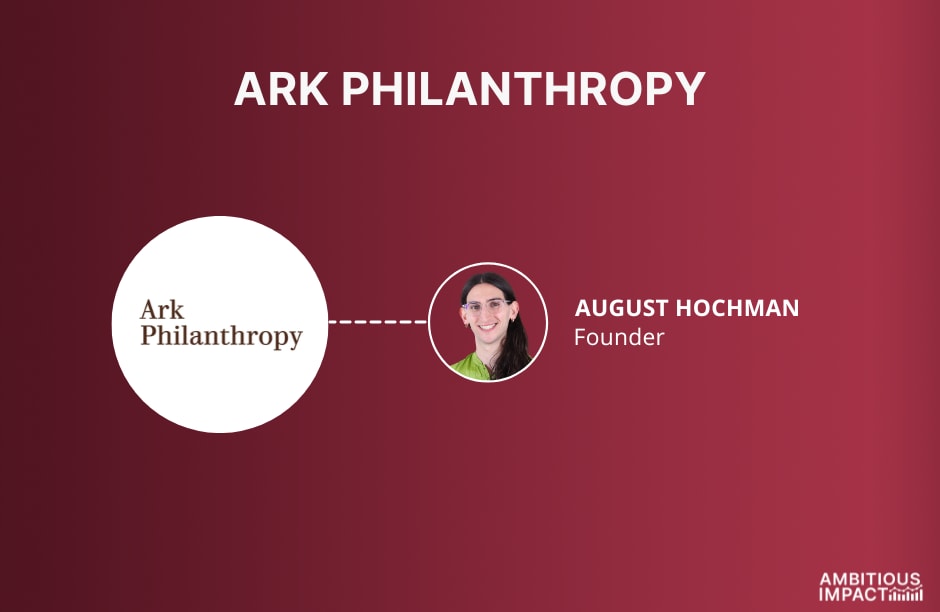
Co-founder: August Hochman
Website: Under Construction
Email address: august@arkphilanthropy.org
CE incubation grant: $65,000
Description of the intervention:
Ark Philanthropy is a high-net-worth donor advisory non-profit. Our mission is to help philanthropists identify ambitious goals to solve global problems and provide them with the tools and resources to develop a clear strategy for success. We work with individuals and families to develop their philanthropic plans and provide them with bespoke grant portfolios and community events.
Background of the intervention:
There are more than 10 million charities worldwide and these organizations make numerous appeals to philanthropists with bold claims about their impact. It can be extremely challenging for philanthropists to determine which are actually the most impactful. Although many high-net-worth individuals (HNWIs) donate to charity, many lack strong advisors to guide them in choosing the most impactful opportunities.
Ark Philanthropy was established to address this gap by providing philanthropists with high-quality, transparent support. Every philanthropist collaborating with us will develop a robust theory of change for their donations and a clear roadmap to achieve their philanthropic goals. By making grants to organizations that meet Ark Philanthropy’s high bar for transparency and impact, our support helps philanthropists achieve their goals.
Near-term plans:
This year, we plan to connect with philanthropists across the United States looking to accelerate their impact and will work with a select few who are particularly promising.
This year, we will
- Build an advisory board of expert grantmakers and charity evaluators to support our grantmaking process.
- Connect with new and experienced philanthropists and provide the most promising connections with philanthropic advisory services.
- Develop engaging content to share with our philanthropic community.
- Host engaging and meaningful philanthropic events.
If you are interested in supporting our work:
- Sign up for our newsletter by emailing august@arkphilanthropy.org
- Feel free to connect with us if you have connections to HNWIs who may benefit from our services (philanthropic planning, bespoke grant portfolios, consultations, etc.). August is always willing to schedule a meeting, learn about individuals' and families’ philanthropic goals, and offer their support.
Predicted Impact:
Over the next 2 to 3 years, we aim to help philanthropists move > $1M towards impactful charitable opportunities.
Cost-effectiveness:
We aim to generate a 15x funding multiplier within five years.
Room for More Funding:
We secured a midline budget for year one through the AIM seed funding network, and we are open to receiving additional funds. With more funding, we can pursue additional high-expected-value opportunities to connect with philanthropists, hire an additional Co-founder more quickly, and host higher-quality events more frequently. Please reach out if you are interested in supporting Ark Philanthropy, and we can discuss funding opportunities in detail.
Taimaka
Co-founders: Justin Graham | Dr. Abubakar Umar
Website: www.taimaka.org
Email address: external@taimaka.org
CE incubation grant: $75,000
Description of the intervention:
Taimaka provides acute malnutrition treatment in northeastern Nigeria using the community management of acute malnutrition (CMAM) model. We provide outpatient and inpatient pediatric care for children aged 1-59 months with moderate or severe acute malnutrition. We partner with the Nigerian government, using existing healthcare facilities while augmenting these facilities with our staff, medical commodities, training, and M+E. In outpatient facilities, children are given weekly doses of therapeutic foods and medications (as well as vaccinations) for 6-10 weeks before discharge. The most severe cases are treated in inpatient hospital facilities and receive round-the-clock care. Treatment costs us ~$106 per child on average.
Background of the intervention:
Taimaka was founded as an EA charity in 2019, and pivoted to acute malnutrition treatment in late 2022. They went through CE's incubation program this year as they evaluated a series of strategic decisions about where to focus their work.
GiveWell has assessed that CMAM treatment is potentially as or more cost-effective than its current top charities and has previously directed funding to some large INGOs providing acute malnutrition treatment. While CMAM is not new, Taimaka works to enhance the standard treatment model through innovative new approaches - sourced from academics, our ideas, and other organizations - to reduce the cost of malnutrition treatment dramatically. CMAM is typically implemented by governments and large INGOs, who are frequently slow to adapt to new opportunities, meaning a smaller organization like Taimaka can make real progress. This approach is already promising: compared to our average cost per severe case treated of $120, it costs the average NGO in northeastern Nigeria $440 to treat a child with severe acute malnutrition.
Near-term plans:
In 2024, we plan to treat 7,400 cases of acute malnutrition in Gombe State, in northeastern Nigeria, expanding from our 2023 pilot program, which treated 3,500 cases. In 2025, we plan to double the size of our treatment program to reach 15,000 patients.
Predicted Impact:
Based on GiveWell’s public modeling of CMAM and our internal program numbers, we expect to save 446 and 905 lives in 2024 and 2025, respectively. We also hope to generate additional benefits (equivalent to ~10-20 additional lives saved each year) through developmental benefits from malnutrition treatment, increased vaccination coverage through our program, and ancillary deaths averted through care in our program for malaria and other diseases (provided to children who are malnourished and suffering from co-morbidities).
[Note - this is not meant to claim GiveWell’s endorsement of our modeling. Our calculations are based on GiveWell’s work but depart from it in meaningful ways. All mistakes are our own.]
Cost-effectiveness:
Based on GiveWell’s public modeling of CMAM and our internal program numbers, we estimate that Taimaka is currently 16.7x as cost-effective as cash transfers, potentially improving to 20.2x at scale as larger patient loads defray our overhead costs. Our modeling is available here.
[Note - this is not meant to claim GiveWell’s endorsement of our modeling. Our calculations are based on GiveWell’s work but depart from it in meaningful ways. All mistakes are our own.]
Room for More Funding:
Taimaka has a remaining funding gap of $500,000 for our 2024 program (treating 7,400 acute malnutrition cases). Additional funding will go directly to treating additional cases, as our facilities currently operate under their maximum capacity due to funding constraints and can admit many more cases than they currently are.
Stan Pinsent @ 2024-05-15T07:55 (+18)
This looks like a particularly strong crop of new orgs. I'm excited to see NOVAH and AMI get started, which (as far as I know) are pioneering totally new interventions. Good luck.
